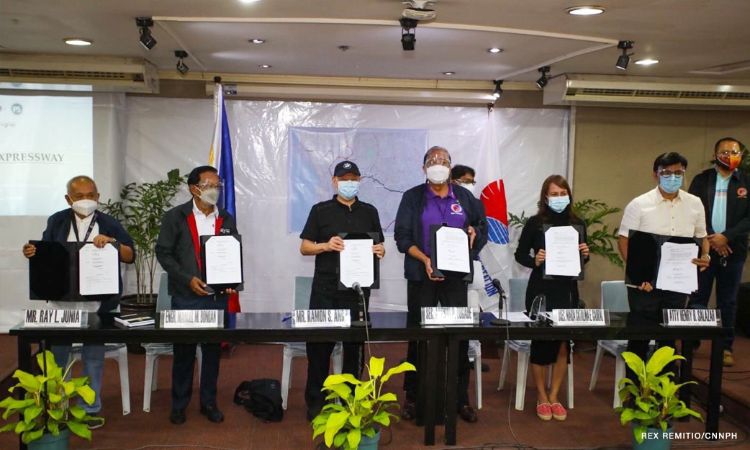Pasig River Expressway construction may begin early 2022
By Rex Remitio | CNN Philippines | September 22, 2021 6:53:33 AM

Pasig River Expressway construction (Photo: CNNPH)
Metro Manila (CNN Philippines, September 22) — The government approved the Pasig River Expressway (PAREX) project more than a year after it was proposed by San Miguel Corporation (SMC).
The 19.37-kilometer elevated expressway is expected to cut travel time between Manila and Rizal province from two hours to only 15 minutes.
The construction may begin within the first three months of 2022 or as soon as SMC gets the Notice to Proceed from the government.
SMC President and CEO Ramon Ang said they are finishing the detailed engineering design for the PAREX project.
“Hinahanda na ho lahat para mabilis ‘yung trabaho,” Ang explained during the signing of the Supplemental Toll Operations Agreement on Tuesday.
[Translation: We are preparing everything to speed up work.]
Ang added the construction of the six-lane elevated road can be completed on or before 2027 or within five years.
SMC will fully shoulder the ₱95-billion cost to build PAREX.
PAREX will run along the banks of Pasig River, from Radial Road 10 in Manila to the portion of C-6 Road in Taguig City near Taytay, Rizal.
It will have entry and exit points in the university belt area in Manila, San Juan City, Buendia Avenue, Mandaluyong City, Makati City, Rockwell, EDSA, Bonifacio Global City (BGC), and C-5 Avenue in Taguig City.
The expressway will also have a bus rapid transit (BRT) system, dedicated bike lanes, pedestrian walkways, jogging paths, and a water ferry system.
“PAREX will also be for pedestrians and cyclists. It will not just be for motorized transportation and convenience, but also for maintaining our health and well-being,” Ang said. “This will be an inclusive, user-centered infrastructure that will integrate various modes of transportation beyond cars.”
SMC said the ferry system will also link people to cities along the waterfronts of Metro Manila, from Manila Bay to Laguna Lake, among others.
Green design principle
The PAREX will combine sustainability features with the functionality of a safe and efficient transport infrastructure, SMC also said.
The diversified conglomerate has tapped renowned architect and environmental planner Jun Palafox, Jr. to help build the project.
“Palafox, acknowledged as the country’s top green urban planner, brings with him decades of experience master-planning some 1,700 projects in 45, countries,” SMC said in a statement.
SMC also tapped Palafox to make sure the New Manila International Airport in Bulacan will be environmentally friendly.
In the 1970s, he was one of the urban planners of Dubai in United Arab Emirates aside from other major cities on the planet.
“Together with Palafox and Associates, we will build what will be the country’s first sustainable infrastructure, one that will not just be ‘green’, but will have multiple uses and direct environmental, social, and economic benefits to Filipinos,” Ang said.
Decongesting Metro Manila traffic
The Department of Transportation (DOTr), meanwhile, said the PAREX will help decongest traffic in the capital region by connecting toll roads and freeways. It will provide faster and alternative access to several business districts, such as Makati, Ortigas, and BGC.
Transportation Secretary Artur Tugade said decongesting traffic will benefit all Filipinos.
Heavy traffic has been one of Metro Manila’s major problems, especially before the COVID-19 pandemic began last year.
The Japan International Cooperation Agency estimated in 2018 that the country was losing ₱ 5.4 billion daily due to traffic congestion.
Advocate groups such as Move as One Coalition, meanwhile, have expressed concerns about the project saying it’s “car-centric.”
The coalition’s convenor Robert Siy said the PAREX will make congestion worse and ramp up the production of greenhouse gases in the country.
“It is high time that we shift away from the outdated car-centric transportation policies of the last century and instead embrace inclusive, people-centered, and sustainable approaches that are now being adapted as best practice all over the world,” Siy added.
SMC said it will conduct more consultations with concerned groups to make sure the project will be inclusive to all stakeholders.
River cleanup projects
The conglomerate has also been continuously dredging, widening, and cleaning up the Pasig River as part of its rehabilitation efforts.
The ₱2-billion Pasig River cleanup project that began last June will last for five years. It aims to remove over three million metric tons of silt and solid waste from the river.
The river was considered dead in the 1990s due to the growing population of the metropolis and their activities that adversely affected the water body.
“We will use the most modern equipment, which we have already acquired, and employ our own engineers and trained personnel,” Ang said.
The conglomerate is also currently undertaking a ₱1-billion cleanup of 27-kilometer Tullahan-Tinajeros River system.
Company officials said 414,000 metric tons of solid waste were removed from the river.
Source: CNN Philippines
